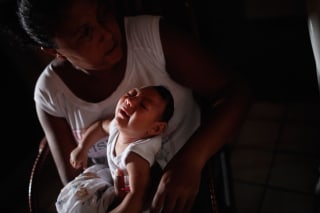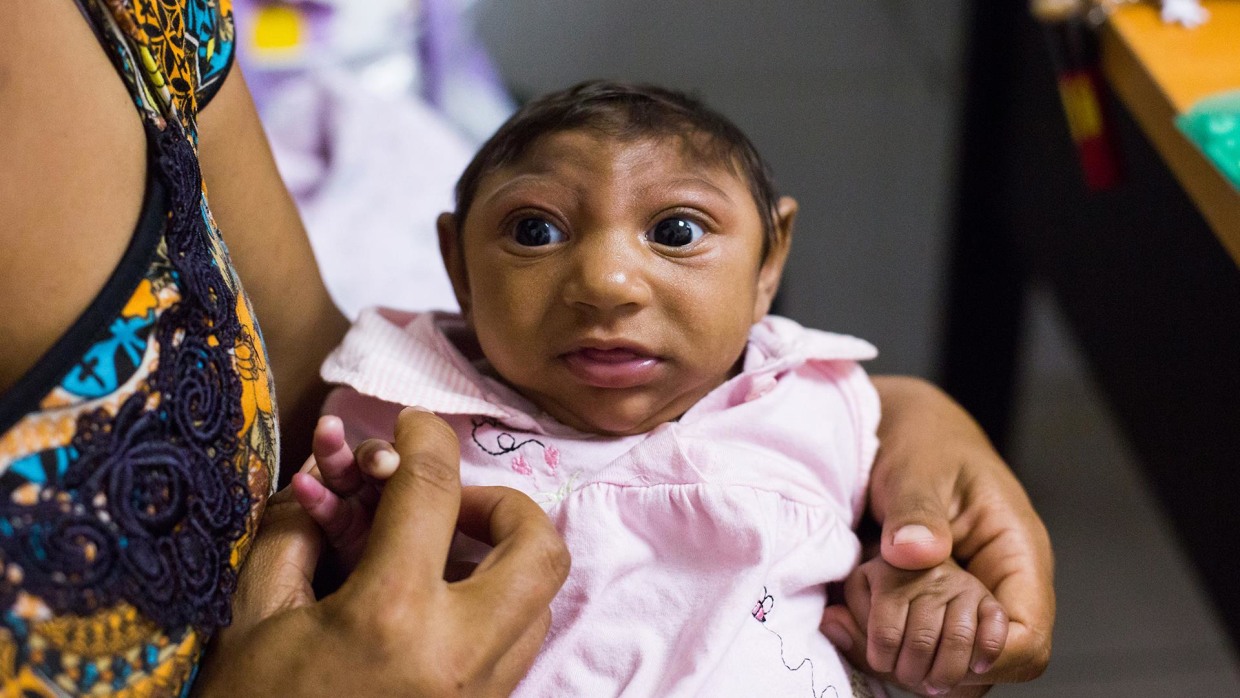
The 2-month-old baby looks exceptional. She’s crawling forward at an age when most infants cannot even roll over. Another tiny infant sits straight up when her foot is tickled.
Sometimes the parents are pleased, and see these behaviors as a sign that Zika may not have damaged their babies as badly as they feared.
Alice Vitoria Gomes Bezerra, who has microcephaly, is held by her mother Nadja Cristina Gomes Bezerra in Recife, Brazil. Mario Tama / Getty Images
But in fact, these reflexes are a sign of the profound mess the virus has made in their developing brains, said Dr. Vanessa Van der Linden, the pediatric neurologist in Recife, Brazil, who sounded the first public alert about Zika.
“That is not usual. That is not normal,” Van der Linden told a meeting on Zika virus in babies sponsored by the (NICHD) National institute of Child Health and Human Development, one of the National Institutes of Health in Bethesda, Maryland.
The reflexes making these young infants seem so developmentally accelerated come from the brain stem, and they are supposed to stop a few weeks after birth. They’re the same reflexes that cause a newborn to grasp her father’s finger or root for her mother’s breast.
The pediatricians, neurologists, and child development specialists in the small meeting room gasp and murmur as Van der Linden shows videos of some of the babies she’s treated at her clinic.
They squall and stiffen their limbs in a way familiar to pediatricians who deliberately startle young infants to check their reflexes.
But these babies aren’t startled, and they don’t relax as they should after a few seconds. They stay stiff — the medical term is hypertonic. And they cry.
“They cry a lot,” Van der Linden told the meeting. “Sometimes they cry 24 hours a day.”
Zika virus continues to spread in many parts of the world, explosively in the warmer parts of Latin America and the Caribbean. It’s caused at least two outbreaks in Florida, which now counts more than 100 homegrown Zika virus infections.
The Centers for Disease Control and Prevention says it’s tracking at least 749 pregnant women with Zika infections in the United States and another 1,348 in territories such as Puerto Rico.
The CDC says 20 babies have been born in the U.S. with Zika-related birth defects and five were miscarried, stillborn or aborted because of catastrophic defects.
What’s becoming clear is that Zika’s hallmark birth defect — microcephaly — is only the most obvious symptom. As babies damaged by Zika infection get to four months, six months, a year old, more problems are showing up.
“I think it is likely that the kinds of findings we are seeing now are the tip of the iceberg,” said Dr. Sonja Rasmussen of the Centers for Disease Control and Prevention.
To Van der Linden, it looks as if their underdeveloped brains continue to operate reflexively, in the way that keeps newborns alive and suckling. These reflexes are good at first, but babies need to outgrow them and behave consciously if they are to grow up normally.
Zika babies often don’t, she said.
Brain scans show seizure-like activity in many of the babies. It’s clearly uncomfortable for them, although giving them pain medication does not seem to help, Van der Linden said.
“Some patients improve only after we treat them for epilepsy,” she said.
Many also have terrible, painful reflux — caused when food and stomach acid bubble up into the esophagus. It’s being caused because the infants are not suckling properly, using the reflex instead of coordinated sucking, she said.
The result is many cannot eat enough. “They often have delayed or impaired gastric emptying,” Van der Linden said.
“The patients sometimes are able to eat only 30 ml of milk,” she said. That’s about a 10th of a cup. “They have a very small capacity to eat,” she said.
Based on that, many Zika-damaged babies may not live long, said Dr. Steven Miller of the Hospital for Sick Children in Toronto, Canada.
“I am not sure how many of the severely affected kids are going to get to school age,” Miller said. “It is hard to imagine the brain growing well without adequate nutrition.”
In addition, some babies born looking normal have regressed, Van der Linden said. “At birth, they were normal. Head circumference was normal. But now they have microcephaly,” she said.
That fits in with other reports showing Zika virus infections may continue to damage a newborn’s brain after birth.
Researchers at the meeting expressed concern about symptoms such as autism and schizophrenia as children who seem to have escaped Zika’s worst damage grow older.
Dr. Camila Ventura of the Bascom Palmer Eye Institute in Miami said her team’s also found some evidence on ongoing damage in the babies’ eyes.
“The babies that have congenital Zika syndrome, their vision is severely impaired,” she said. The eyes look normal, but they don’t function properly, Ventura said.
“The children need to be monitored for some time. Some of these manifestations are only beginning to show months out,” said NICHD director Dr. Catherine Spong.
“The impact on the family cannot be understated.”
[“source-nbcnews”]











